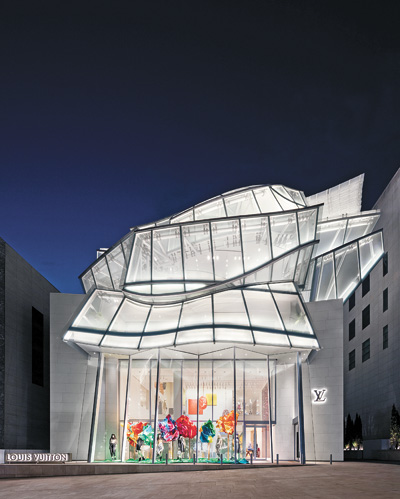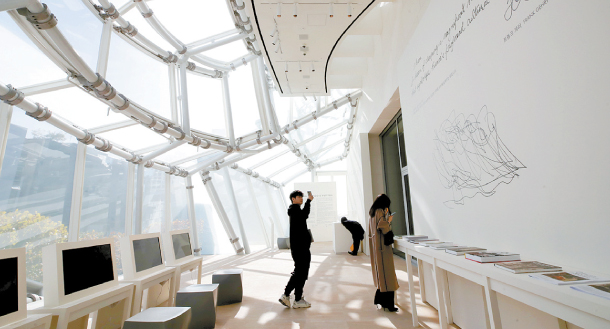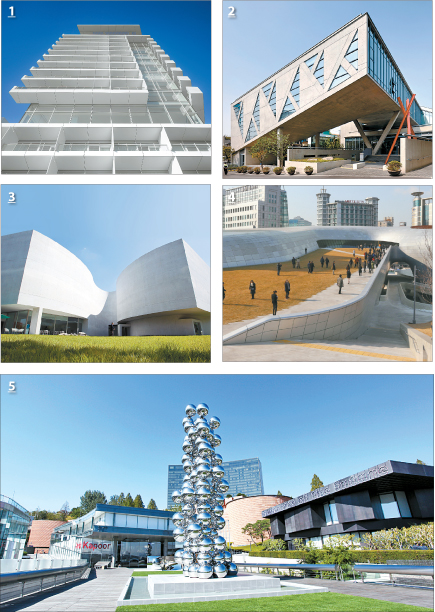Big buildings, bold statements: Louis Vuitton brings Frank Gehry to Korea for its new flagship

Louis Vuitton Maison Seoul in Gangnam District, southern Seoul, 2019, by Frank Gehry. [LOUIS VUITTON MAISON SEOUL]
Gehry, a Canadian-born American architect, is one of the biggest names in contemporary architecture, and is the mastermind behind global attractions like the Guggenheim Museum in Bilbao, Spain, the Walt Disney Concert Hall in Laos Angeles and the Louis Vuitton Foundation in Paris. Last month, Louis Vuitton unveiled its latest boutique and exhibition space, Louis Vuitton Maison Seoul. For his Korean debut, Gehry chose to present a lofty glass building that creates the illusion of waves gently crashing against the shore, much like the Louis Vuitton Foundation in Paris, whose miniature model is on view for the public on the Maison’s top floor.
The 90-year-old architect, who visited Korea for the opening, said he was also inspired by the Unesco World Heritage-designated Hwaseong Fortress in Suwon, Gyeonggi, and the dongraehak dance, which imitates the graceful movements of cranes.
“What struck me when I first visited Seoul nearly 25 years ago, was the relationship between the architecture and the natural landscape,” explained Gehry in a statement published by Louis Vuitton. “I am delighted to have designed Louis Vuitton Maison Seoul, reflecting the traditional values of the Korean culture.”
The latest creation by the legendary architect has been met with a generally favorable response from local architecture experts, who appreciate the design for paying homage to Korean imagery.

The new Louis Vuitton Maison Seoul boutique and exhibition space, which opened last month, is Pritzker-winning architect Frank Gehry’s first project in Korea. [YONHAP]
“It seems like Gehry was inspired by the movement of the white clothing worn by dongraehak dancers when he created the fluid shape of the Maison. I think that went down really well with the fact that Louis Vuitton is a fashion brand,” Prof. Jung Hye-jin of Inha University told the Korea JoongAng Daily. “The upper floors that make up the building’s voluminous top also offer a fantastic view of the surrounding areas.”
Before Gehry’s building, the most buzzed-about structure in Seoul was late architect Zaha Hadid’s futuristic Dongdaemun Design Plaza (DDP), which was perhaps the most controversial piece of contemporary architecture built by a foreign architect in Korea. Other popular buildings by star archietects in Korea include Ando Tadao’s Yumin Art Nouveau Collection gallery in Jeju Island and Richard Meier’s Seamarq Hotel in Gangneung, Gangwon. Others are on their way, including the SongEun ArtSpace and Samtan HQ by Swiss architecture firm Herzog & de Meuron and the 72-story commercial and office complex Yeouido Parc 1 by British architect Richard Rogers.
Given the name value of the architects behind them, these structures have served as attractions for overseas tourists to Korea and emerged as highly sought-out venues for local event organizers.

1. Seamarq Hotel in Gangneung, Gangwon, 2015, by Richard Meier; 2. Jaeneung Culture Center (JCC) in Jongno District, central Seoul, 2015, by Ando Tadao; 3. Mimesis Art Museum in Paju, Gyeonggi, 2009, by Alvaro Siza; 4. Dongdaemun Design Plaza in Jung District, central Seoul, 2014, by Zaha Hadid; 5. Leeum Samsung Museum of Art in Yongsan District, central Seoul, 2004, by Rem Koolhaas, Mario Botta and Jean Nouvel. [SEAMARQ HOTEL, JCC, JOONGANG ILBO, LEEUM SAMSUNG MUSEUM OF ART]
Works by Pritzker prize-winners are not always welcomed with open arms, however.
When Hadid’s behemoth steel design for the DDP was chosen for construction on the site of Dongdaemun Stadium, it faced fierce protest from the local architectural community for disregarding the landscape of the neighborhood. In a 2013 survey conducted by 100 Korean architects and design critics, DDP was ranked fifth on a list of the worst buildings constructed in Korea since independence in 1945.
“Structures designed by world-famous architects have a high degree of completeness no matter where they’re built. But they are often designed in their own styles rather than taking into regard Seoul’s urban landscape or applying materials that reflect regional characters,” explained Prof. Kim Jung-gon of Konkuk University.
“The DDP boasts [Hadid’s] own architectural style, while Leeum, rather than emphasis being given to the function of the gallery, is a reflection of the tastes of a client who wanted to collect works by certain architects. It’s easy for them to stick out from a continuous cityscape when focus is only given to [the architects’] name value, like a luxury handbag.”
Despite the plethora of works by Pritzker winners in Korea, Prof. Kim Yon-jun of Mokwon University also believes that there isn’t one specific building that can stand on its own and serve as an international landmark.
“I don’t think Korea has a structure built on the same level as Gehry’s Guggenheim Museum in Bilbao or Hadid’s Heydar Aliyev Center in Baku, Azerbaijan. Not all works by Pritzker winners are going to be equal. It’s the same with painters — Vincent van Gogh created thousands of artworks but only a handful are famous.”
There is still value to be found in the fact that these architects are launching projects in Korea and working with local collaborators, others believe.
“It’s important to note that these foreign ‘starchitects’ are enriching the urban landscape with new creative and diverse experiences, and in the process collaborating with local engineers and technology to materialize their special designs,” said Prof. Jung.
“Rather than discussing whether the Maison Seoul is good or bad, a bigger implication is that it was built in Seoul,” agreed Prof. Lee. “The fact that a world-famous architect like Gehry would design in Seoul is a testament to how global and progressive the city is. We need to continue fostering an environment where talented architects — both foreign and local — can create meaningful designs.”
BY KIM EUN-JIN [kim.eunjin1@joongang.co.kr]










with the Korea JoongAng Daily
To write comments, please log in to one of the accounts.
Standards Board Policy (0/250자)